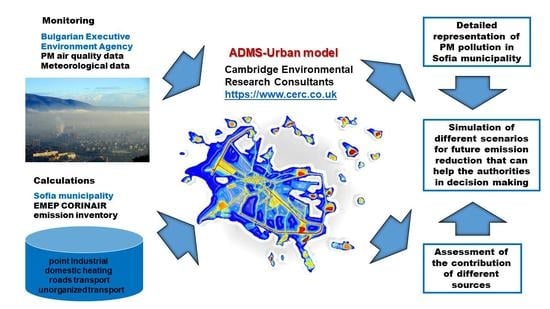Assessment of the Contribution of Different Particulate Matter Sources on Pollution in Sofia City
Abstract
1. Introduction
2. Experimental Design and Methodology
2.1. ADMS-Urban System
2.2. Model Set-Up
2.3. Emission Inventory
2.4. Observations
2.5. Meteorological Input
3. Results
3.1. Model Validation
3.2. Ground Concentration Fields of Different Pollutants
3.3. Contribution of Different Sources to Ground Concentration Field
3.3.1. Spatial Distribution Maps of the Contribution of Different Sources of PM10
3.3.2. Spatial Distribution Maps of the Contribution of Different Sources of PM2.5
3.3.3. Spatial Distribution Maps of Contribution of Different Sources of PAH
3.3.4. Contribution of Different Sources over the Entire Domain
3.4. Ground Maximum Concentration Fields of Different Pollutants
4. Discussion
- It is necessary to start a campaign for collecting new and analyzing the currently existing information from different agencies and departments in order to create more adequate local emission inventory. From the currently existing emission inventories (including the most recently developed and published in December 2020, which was not used in this study [51]), it is apparent that there is a lack of information in several fields:
- (i)
- The available data of the dynamics and structure of the traffic flow on the major road arteries, shows only the mean number of vehicles passed through them for 24 h. It is necessary to determine the daily and the weekly profiles of traffic flow, as well as to create an averaged profile of the structure of traffic flow on the different segments, located between junctions. The rush hour, especially in the mornings, coincides with the more unfavorable meteorological conditions, i.e., stable stratification and absence of turbulence, which favors longer retention of the pollutant in the atmosphere. The structure of the traffic flow is different in the central city part and for example on city ring road Okolovrasten pat, where the fraction of heavy goods vehicles should be greater. Without data for such profiles, type of the road, movement speed, fuel consumption, stay at traffic lights, etc., it is impossible to use software for detailed vehicle inventory, such as COPERT (the EU standard vehicle emissions calculator [52]), EMIT (Atmospheric Emissions Inventory Toolkit [53]), etc. The usage of this type of software will allow to differentiate the busiest and problematic points in the urban road infrastructure and provide possibilities for development of models for establishing an intelligent transport systems for traffic management. These models would easily show the effect of redirecting the traffic flow or part of it from certain boulevard to another boulevard/street and the respective impact on the pollution field. This would be useful for introducing adequate measures for decreasing the pollution emissions from the transport.
- (ii)
- It is also necessary to collect information and create data base of the annual average mileage of the registered in the city vehicles by district and what is the percentage of kilometers travelled in the city. This will help with defining the quantity of unorganized transport from minor roads in residential areas more accurately, which are not included in the road sources.
- The complex terrain requires more realistic presentation of the air flow and a lot of additional meteorological variables in order to adequately model the air quality, and one point (for example one AQS) is not presentable for the entire domain. Regardless of the use of the complex terrain module in the last generation of Gaussian models such as ADMS-Urban and AERMOD (steady-state Gaussian air dispersion model that is US Environmental Protection Agency approved [54]), which allow calculation of the disturbances in the 3D field of flow and turbulence, it assumes homogeneity of the meteorological variables and the boundary layer over the entire domain. For a larger domain, those fields are extremely heterogeneous. For more realistic and detailed management of the meteorological input parameters, which are used for dispersion modeling, it would help to use a field simulated by a regional model for weather forecast (for example Weather Research and Forecasting Model with high resolution ~1 km). This would allow an adequate spatial and temporal variability of the meteorological conditions to be entered for the research domain and will be used in the future studies.
- The physical environment, represented by the urban morphology, described in digital 3D arrays is of utmost importance for the presentation of the fluctuations in the pollution field and for the definition of the maximal pollution areas under different meteorological conditions. The presence of this type of data will allow for more accurate determination of the required characteristics in order for more detailed modules to be used, which describe urban street canyon (the parameters should be defined for both sides of the road; height of the buildings; distance from the central line of the road to the canyons’ wall; length of the buildings near the road; width of the road), this allows for more realistic presentation of the object. This data are also very useful for more accurate definition of the mean building height, when the domestic heating sources are considered.
- The problem with entering the background concentration is still not resolved. AQS Kopitoto is used as background site, but the data are not presentable for all of the observed meteorological conditions in the region, since the meteorological site is located on high altitude. The pollution in Sofia field is impacted by the predominant flow in direction of the valleys’ axis from northwest and southeast coming from sources in the Sofia municipality outskirts. It is necessary to establish at least two background sites, according to the assigned parameters and requirements of the European and the national legislation. The sites should be located far enough from the Sofia municipality in the northwest and southeast direction from the city.
5. Conclusions
- The contribution of the different types of sources to the modeled annual concentration, which is averaged over the entire domain, shows that the input of the domestic heating sources for all of the pollutants is most significant, followed by the contribution of transport from the main road arteries, which is more essential for PM in comparison with PAH, and area transport sources. The less notable contribution is from the point sources for all of the considered pollutants (below 2%).
- Despite the importance of the impact of the domestic heating sources, averaged over the domain, we should keep in mind one essential factor, when we determine the required measures to reduce the harmful impact of the considered pollutants (PM10, PM2.5, PAH). The concentration field in Sofia city and the surrounding areas is mostly heterogeneous. Considering the contribution of the different types of sources of PM, shows the substantial impact of transport (described as road—the main road arteries with heavy traffic, as well as the area transport sources from the minor roads in residential areas) on air quality in the central parts of the city, where the pollution is mostly local, in proximity of the source. The contribution of the domestic heating from wood and coal burning is highest in the city’s outskirts and in the small towns in the Sofia municipality. The effect of the domestic heating sources in the central city parts is notably lower, because of the use of alternative heating methods (central heating, electricity, gas), and also this contribution is valid only for the cold season.
- The locations of the maximal daily simulated concentrations during the year shows the formation of clusters, regardless of the various meteorological conditions. The highest concentrations of PM occurred at the northwestern and southern part of the city, and the southeastern outskirts in the village of German. The most polluted area of PAH is Filipovtsi residential area. The city ring road and main boulevards with heavy traffic contribute substantially to the “hot spots” of the most polluted areas.
- Despite of some uncertainties in the presented research, which are described above, the estimated contribution of the different source types, gives us a useful information on temporal–spatial distribution of the pollution, which cannot be obtained by using the data from the five AQSs, where the concentration of PM10 is measured, and only one, where the concentrations of PM2.5 and PAH are measured. Moreover, the locations of the obtained maximal concentration clusters are far away from the existing sites.
Author Contributions
Funding
Institutional Review Board Statement
Informed Consent Statement
Data Availability Statement
Acknowledgments
Conflicts of Interest
Appendix A
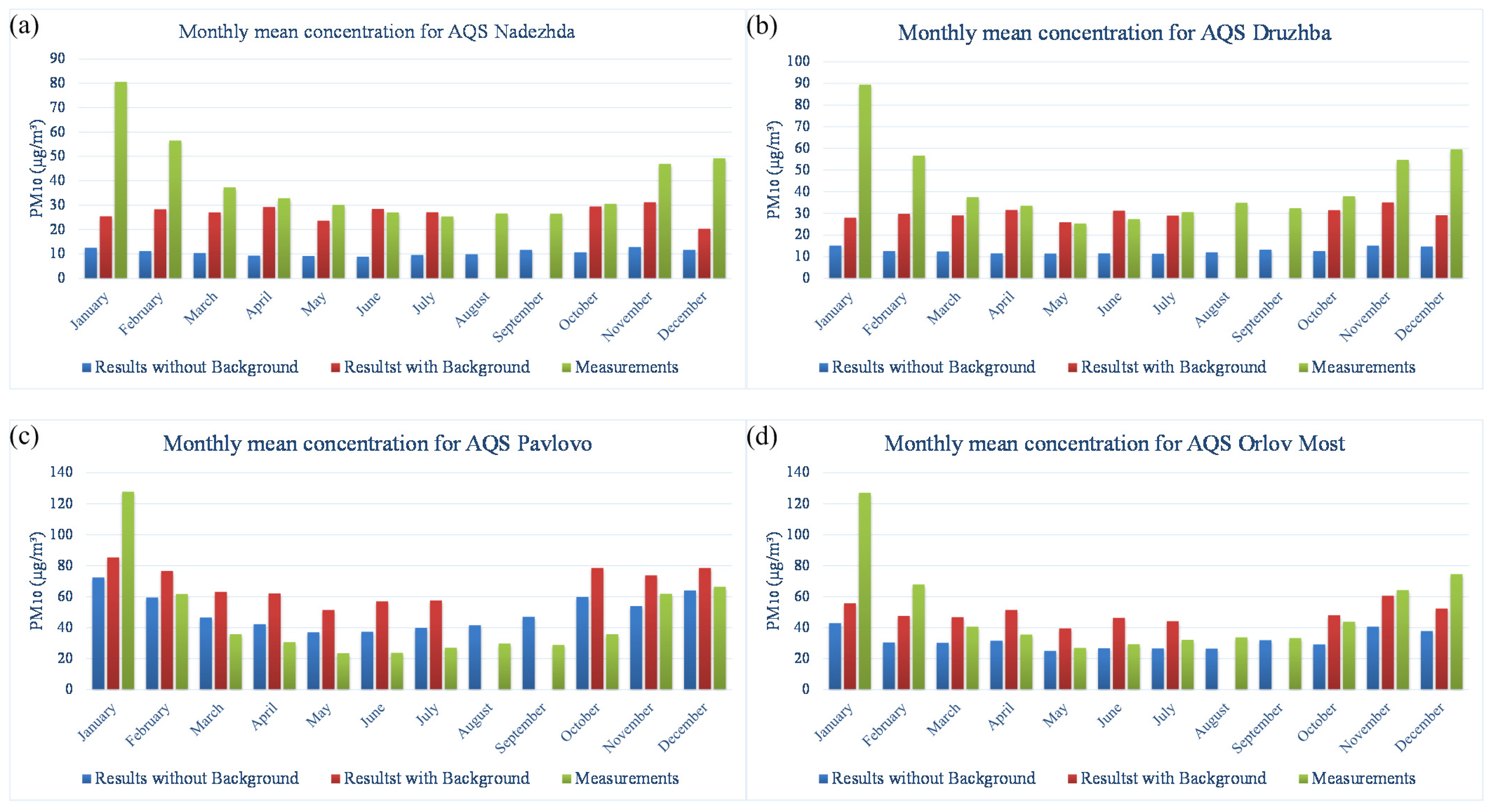

References
- European Environment Agency. Air Quality in Europe—2017 Report, EEA Report No 13/2017. Available online: https://www.eea.europa.eu/publications/air-quality-in-europe-2017 (accessed on 9 January 2021).
- Oke, T.R.; Mills, G.; Christen, A.; Voogt, J.A. Urban Climates, 1st ed.; Cambridge University Press: Cambridge, UK, 2017; pp. 294–295. [Google Scholar]
- Commission of the European Communities. Brussels, 21.9.2005. COM (2005) Final. Available online: https://eur-lex.europa.eu/LexUriServ/LexUriServ.do?uri=COM:2005:0446:FIN:EN:PDF (accessed on 9 January 2021).
- National Emission Ceilings Directive, 2001/81/EC. Available online: https://www.eea.europa.eu/themes/air/air-pollution-sources-1/national-emission-ceilings (accessed on 9 January 2021).
- EU Directive 2008/50/EC, Air Quality. Available online: https://www.eea.europa.eu/policy-documents/directive-2008–50-ec-of (accessed on 9 January 2021).
- European Environment Agency. Air Quality in Europe—2020 Report, No 09/2020. Available online: https://www.eea.europa.eu/publications/air-quality-in-europe-2020-report (accessed on 9 January 2021).
- European Commission. Special Eurobarometer. Attitudes of Europeans Towards Air Quality. Available online: https://data.europa.eu/euodp/en/data/dataset/S2239_92_1_497_ENG (accessed on 9 January 2021).
- United Nations. DESA/Population Division World Urbanization Prospects: The 2018 Revision. Available online: https://www.un.org/development/desa/publications/2018-revision-of-world-urbanization-prospects.html (accessed on 9 January 2021).
- Executive Environment Agency. National Report on the State of Environment in Bulgaria–2017. Available online: http://eea.government.bg/bg/soer/2018/air/kachestvo-na-atmosferniya-vazduh (accessed on 9 January 2021). (In Bulgarian)
- Romero-Lankao, P.; Dodman, D. Cities in transition: Transforming urban centers from hotbeds of GHG emissions and vulnerability to seedbeds of sustainability and resilience: Introduction and editorial overview. Curr. Opin. Environ. Sustain. 2011, 3, 113–120. [Google Scholar] [CrossRef]
- Bulgarian National Statistical Institute. Population and Demographic Processes 2017. Available online: http://www.nsi.bg/sites/default/files/files/publications/DMGR2019.pdf (accessed on 9 January 2021).
- Ganev, K. Some results of the numerical modelling of mesometeorological processes in the Sofia field. Bulg. Geoph. J. 1981, VII, 3–15. (In Bulgarian) [Google Scholar]
- Ganev, K.; Yordanov, K. Some examples of admixture transport in the Sofia field. Bulg. Geoph. J. 1981, VII, 16–28. (In Bulgarian) [Google Scholar]
- Ganev, K.; Yordanov, D. On the formulation of the influence function problem in air pollution models with parameterized diffusion in the surface layer. Bulg. Geoph. J. 1983, IX, 25–35. (In Russian) [Google Scholar]
- Dimitrova, R. Three-layer model of mesoscale pollution in the atmosphere. Bulg.Geoph. J. 1997, XXIII, 29–40. [Google Scholar]
- Atanassov, D. Local scale PC-oriented Eulerian pollutant transport model PolTran-1–2. Int. J. Environ. Pollut. 2000, 14, 217–224. Available online: https://www.researchgate.net/publication/264814627 (accessed on 9 January 2021). [CrossRef]
- Gromkova, N.; Ganev, K.; Yordanov, D.; Georgieva, E.; Dimitrova, R.; Miloshev, N. Dispersion regulatory model for designing new industrial stacks–Software. In Proceedings of the 8th International Conference on Harmonization within Atmospheric Dispersion Modelling for Regulatory purposes, Sofia, Bulgaria, 14–17 October 2002; pp. 180–184. [Google Scholar]
- Dimitrova, R.; Ganev, K. Simple pollution transport model with parameterized vertical structure, NATO ARW on “Air Pollution Processes in Regional Scale”, Halkidiki, Greece, 13–16 June 2002. In NATO Science (Series IV: Earth and Environmental Sciences); Springer: Dordrecht, The Netherlands, 2003; Volume 30. [Google Scholar] [CrossRef]
- Dimitrova, R.; Ganev, K.; Zerefos, C.; Vasaras, A. Exchange of sulfur and nitrogen compounds between Bulgaria and Greece, estimated with a simple tree-layer pollution transport model. Bulg. Geoph. J. 2000, XXVI, 114–123. [Google Scholar]
- Ganev, K.; Syrakov, D.; Zerefos, C.; Prodanova, M.; Dimitrova, R.; Vasaras, A. On some cases of extreme sulfur pollution in Bulgaria or Northern Greece. Bulg. Geoph. J. 2002, XXVIII, 15–92. [Google Scholar]
- Ganev, K.; Dimitrova, R.; Syrakov, D.; Zerefos, C. Accounting for the meso-scale effects on the air pollution in some cases of large sulfur pollution in Bulgaria or Northern Greece. Environ. Fluid Mech. 2003, 3, 41–53. [Google Scholar] [CrossRef]
- Zerefos, C.; Syrakov, D.; Ganev, K.; Vasaras, A.; Kourtidis, K.; Tzortziou, M.; Prodanova, M.; Dimitrova, R.; Georgieva, E.; Yordanov, D.; et al. Study of the pollution exchange between Bulgaria and Northern Greece. Int. J. Environ. Pollut. 2004, 22, 163–185. [Google Scholar] [CrossRef]
- Syrakov, D.; Spiridonov, V.; Prodanova, M.; Bogatchev, A.; Miloshev, N.; Ganev, K.; Katragkou, E.; Melas, D.; Poupkou, A.; Markakis, K.; et al. A system for assessment of climatic air pollution levels in Bulgaria: Description and first steps towards validation. Int. J. Environ. Pollut. 2011, 46, 8–42. [Google Scholar] [CrossRef]
- Syrakov, D.; Ganev, K.; Prodanova, M.; Miloshev, N.; Slavov, K. Fine resolution modeling of climate change impact on future air quality over Bulgaria. In Proceedings of the 32nd NATO/SPS International Technical Meeting on Air Pollution Modelling and its Application, Utrecht, The Netherlands, 7–11 May 2012. [Google Scholar]
- Gadzhev, G.; Ganev, K.; Miloshev, N.; Syrakov, D.; Prodanova, M. Some basic facts about the atmospheric composition in Bulgaria—Grid Computing Simulations. In Large-Scale Scientific Computing. LSSC 2013. Lecture Notes in Computer Science, 8353; Lirkov, I., Margenov, S., Waśniewski, J., Eds.; Springer: Berlin/Heidelberg, Germany, 2014; pp. 484–490. [Google Scholar]
- Gadzhev, G.; Ganev, K.; Miloshev, N.; Syrakov, D.; Prodanova, M. Analysis of the processes which form the air pollution pattern over Bulgaria. In International Conference on Large-Scale Scientific Computing; 8353 LNCS; Springer: Berlin/Heidelberg, Germany, 2014; pp. 390–396. [Google Scholar]
- Georgieva, I.; Gadzhev, G.; Ganev, K.; Prodanova, M.; Syrakov, D.; Miloshev, N. Numerical study of the air quality in the city of Sofia–Some preliminary results. Int. J. Environ. Pollut. 2015, 57, 162–174. [Google Scholar] [CrossRef]
- Georgieva, I.; Gadzhev, G.; Ganev, K.; Melas, D.; Wang, T. High Performance Computing Simulations of the Atmospheric Composition in Bulgaria and the City of Sofia. Cybern. Inf. Technol. 2017, 17. [Google Scholar] [CrossRef]
- Dimitrova, R. Air flows and pollution transport in the Sofia valley under highly stable background conditions. Bulg. Geoph. J. 2001, XXVII, 124–136. [Google Scholar]
- Ganev, K.; Dimitrova, R.; Miloshev, N. Air flows and pollution transport in the Sofia valley under some typical background conditions. In Air Pollution Modeling and Its Application XVI; Borrego, C., Incecik, S., Eds.; Springer: Boston, MA, USA, 2003; pp. 593–594. [Google Scholar]
- Syrakov, D.; Etropolska, I.; Prodanova, M.; Slavov, K.; Ganev, K.; Miloshev, N.; Ljubenov, T. Downscaling of Bulgarian Chemical Weather Forecast from Bulgaria region to Sofia city. Proc. Am. Inst. Phys. 2013, 1561, 120–132. [Google Scholar] [CrossRef]
- Todorova, A.; Syrakov, D.; Gadzhev, G.; Georgiev, G.; Ganev, K.; Prodanova, M.; Miloshev, N.; Spiridonov, V.; Bogatchev, A.; Slavov, K. Grid computing for atmospheric composition studies in Bulgaria. Earth Sci. Inform. 2010, 3, 259–282. [Google Scholar] [CrossRef]
- Etropolska, I.; Syrakov, D.; Ganev, K.; Prodanova, M.; Miloshev, N.; Slavov, K.; Jordanov, G. A system for information and forecasting of air quality over Bulgaria. In Proceedings of the 13th International Conference on Harmonisation within Atmospheric Dispersion Modelling for Regulatory Purposes, Paris, France, 1–4 June 2010; pp. 530–534, ISBN 2-8681-5062-4. [Google Scholar]
- Syrakov, D.; Prodanova, M.; Etropolska, I.; Ganev, K.; Miloshev, N.; Slavov, K.; Jordanov, G. Automated system for chemical weather forecast in Bulgaria. Bulg. J. Meteorol. Hydrol. 2011, 16, 30–40. [Google Scholar]
- Syrakov, D.; Prodanova, M.; Etropolska, I.; Slavov, K.; Ganev, K.; Miloshev, N.; Ljubenov, T. A Multy-Domain Operational Chemical Weather Forecast System. In Large-Scale Scientific Computing. LSSC 2013. Lecture Notes in Computer Science 8353; Lirkov, I., Margenov, S., Waśniewski, J., Eds.; Springer: Berlin/Heidelberg, Germany, 2014; pp. 413–420. [Google Scholar] [CrossRef]
- Syrakov, D.; Prodanova, M.; Georgieva, E. Performance of the Bulgarian WRF-CMAQ modelling system for three subdomains in Europe. Física de la Tierra 2015, 27, 137–153. [Google Scholar]
- Syrakov, D.; Prodanova, M.; Georgieva, E.; Etropolska, I.; Slavov, K. Simulation of European air quality by WRF–CMAQ models using AQMEII-2 infrastructure. J. Comput. Appl. Math. 2015, 293, 232–245. [Google Scholar] [CrossRef]
- Georgieva, E.; Syrakov, D.; Prodanova, M.; Etropolska, I.; Slavov, K. Evaluating the performance of WRF-CMAQ models in Bulgaria by means of the delta tool. In Proceedings of the 16th International Conference on Harmonisation within Atmospheric Dispersion Modelling for Regulatory Purposes, Varna, Bulgaria, 8–11 September 2014; pp. 304–308. [Google Scholar]
- Georgieva, E.; Syrakov, D.; Prodanova, M.; Etropolska, I.; Slavov, K. Evaluating the performance of WRF-CMAQ air quality modelling system in Bulgaria by means of the DELTA tool. Int. J. Environ. Pollut. 2015, 57. [Google Scholar] [CrossRef]
- Gadzhev, G.; Ganev, K.; Syrakov, D.; Miloshev, N.; Prodanova, M. Contribution of Biogenic Emissions to the Atmospheric Composition of the Balkan Region and Bulgaria. Int. J. Environ. Pollut. 2012, 50, 130–139. [Google Scholar] [CrossRef]
- Skamarock, W.C.; Klemp, J.B.; Dudhia, J.; Gill, D.O.; Barker, D.M.; Duda, M.G.; Huang, X.-Y.; Wang, W.; Powers, J.G. A Description of the Advanced Research WRF Version 3; NCAR Tech. Note NCAR/TN-475+STR.; University Corporation for Atmospheric Research: Boulder, CO, USA, 2008. [Google Scholar] [CrossRef]
- Byun, D.W.; Schere, K.L. Review of the governing equations, computational algorithms, and other components of the models-3 community multiscale air quality (CMAQ) modeling system. Appl. Mech. Rev. 2006, 59, 51–77. [Google Scholar] [CrossRef]
- Petrov, A. Analysis of modelled distribution of air pollutants around buildings at different meteorological conditions. Bulg. J. Meteorol. Hydrol. 2019, 23, 58–68. (In Bulgarian) [Google Scholar]
- CERC_ADMS-Urban5.0_User_Guide.pdf. Available online: https://www.cerc.co.uk/environmental-software/assets/data/doc_userguides/CERC_ADMS-Urban5.0_User_Guide.pdf (accessed on 29 January 2021).
- Stocker, J.; Hood, C.; Carruthers, D.; McHugh, C. ADMS-Urban: Developments in modelling dispersion from the city scale to the local scale. Int. J. Environ. Pollut. 2012, 50, 308–316. [Google Scholar] [CrossRef]
- Hood, C.; MacKenzie, I.; Stocker, J.; Johnson, K.; Carruthers, D.; Vieno, M.; Doherty, R. Air quality simulations for London using a coupled regional-to-local modelling system. Atmos. Chem. Phys. 2018, 18, 11221–11245. [Google Scholar] [CrossRef]
- Biggart, M.; Stocke, J.; Doherty, R.M.; Wild, O.; Hollaway, M.; Carruthers, D.; Li, J.; Zhang, Q.; Wu, R.; Kotthauset, S.; et al. Street-scale air quality modelling for Beijing during a winter 2016 measurement campaign. Atmos. Chem. Phys. 2020, 20, 2755–2780. [Google Scholar] [CrossRef]
- Sofia Municipality. Atmospheric Air Quality Management Program of Capital Municipality for the Period 2015–2020–Reduction of Emissions and Reach of the Established Norms for Fine Particles PM10. Available online: https://www.sofia.bg/documents/20182/298121/Project_Program_KAV_Sofia_2015–2020.pdf/23a572ba-77ac-45a4-b627-c77ea0e225c7 (accessed on 29 January 2021). (In Bulgarian)
- Sofia Municipality. Program for Supplementation of the Program Atmospheric Air Quality Management Program of Capital Municipality for the Period 2015–2020-Reduction of Emissions and Achievement of the Established Norms for Fine Particles PM10, by Indicators Fine Particles with Size up to 2.5 Microns and Polycyclic Aromatic Hydrocarbons. Available online: https://air.sofia.bg/media/Documents/R.523-Pr1.pdf (accessed on 29 January 2021). (In Bulgarian)
- Willmott, C.J. On the validation of models. Phys. Geogr. 1981, 2, 184–194. [Google Scholar] [CrossRef]
- Sofia Municipality. Program for Improving the Air Quality on the Territory of Sofia Municipality for the Period 2021–2026. Available online: https://sofia.bg/web/guest/programa-kav/-/asset_publisher/4gAwAlBEGMRL/content/proekt-predvaritelen-variant-na-kompleksna-programa-za-podobravane-kacestvoto-na-atmosfernia-v-zduh-na-teritoriata-na-stolicna-obsina-za-perioda-2021-?redirect=%2Fweb%2Fguest%2Fprograma-kav&inheritRedirect=true (accessed on 29 January 2021). (In Bulgarian)
- COPERT. Available online: https://www.emisia.com/utilities/copert-street-level/ (accessed on 29 January 2021).
- Atmospheric Emissions Inventory Toolkit, User Guide v. 3.4 CERC, June 2015, Cambridge, UK. Available online: https://www.cerc.co.uk/environmental-software/EMIT-tool.html (accessed on 29 January 2021).
- AERMOD. Available online: https://www.epa.gov/scram/air-quality-dispersion-modeling-preferred-and-recommended-models#aermod (accessed on 29 January 2021).
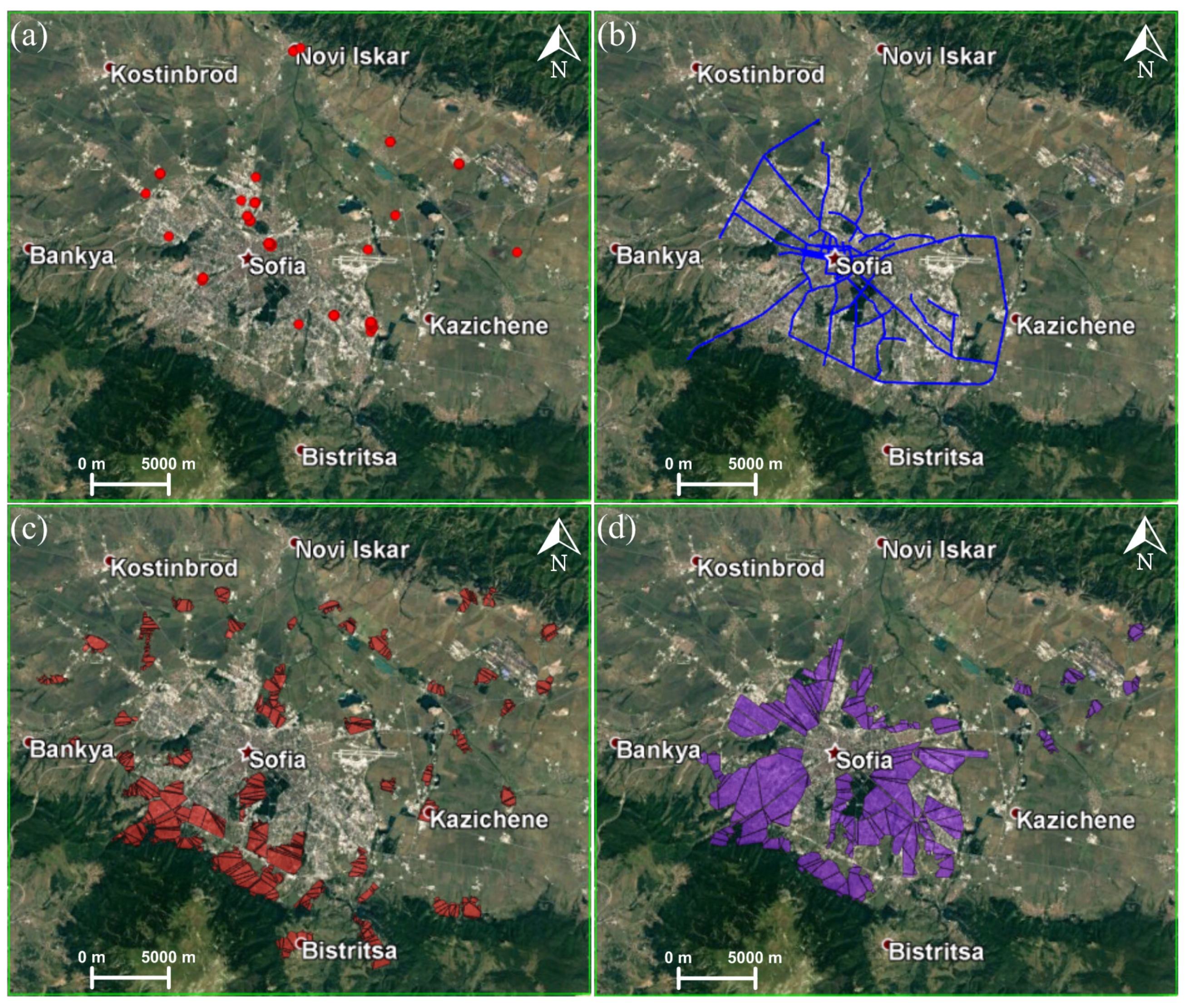
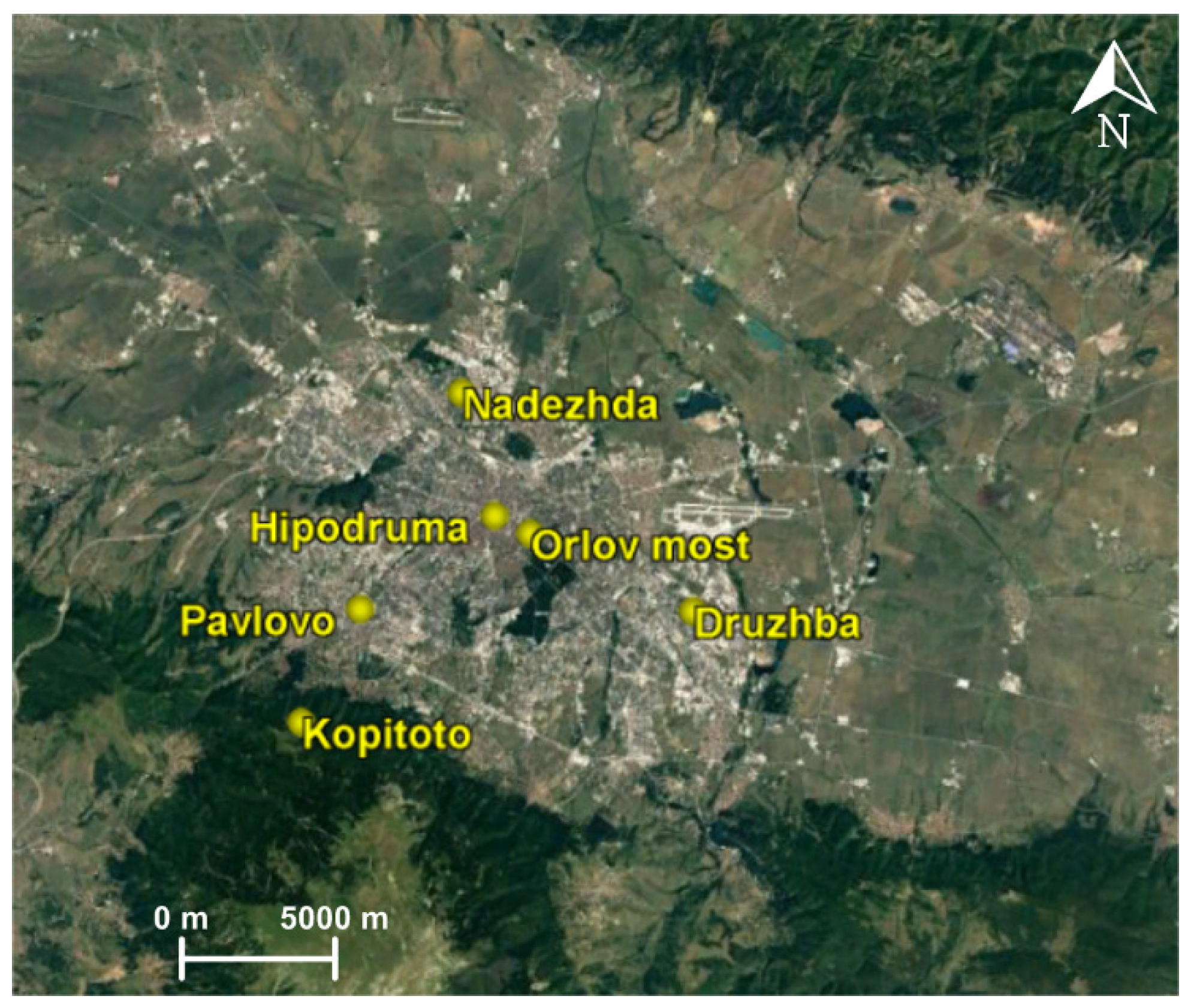
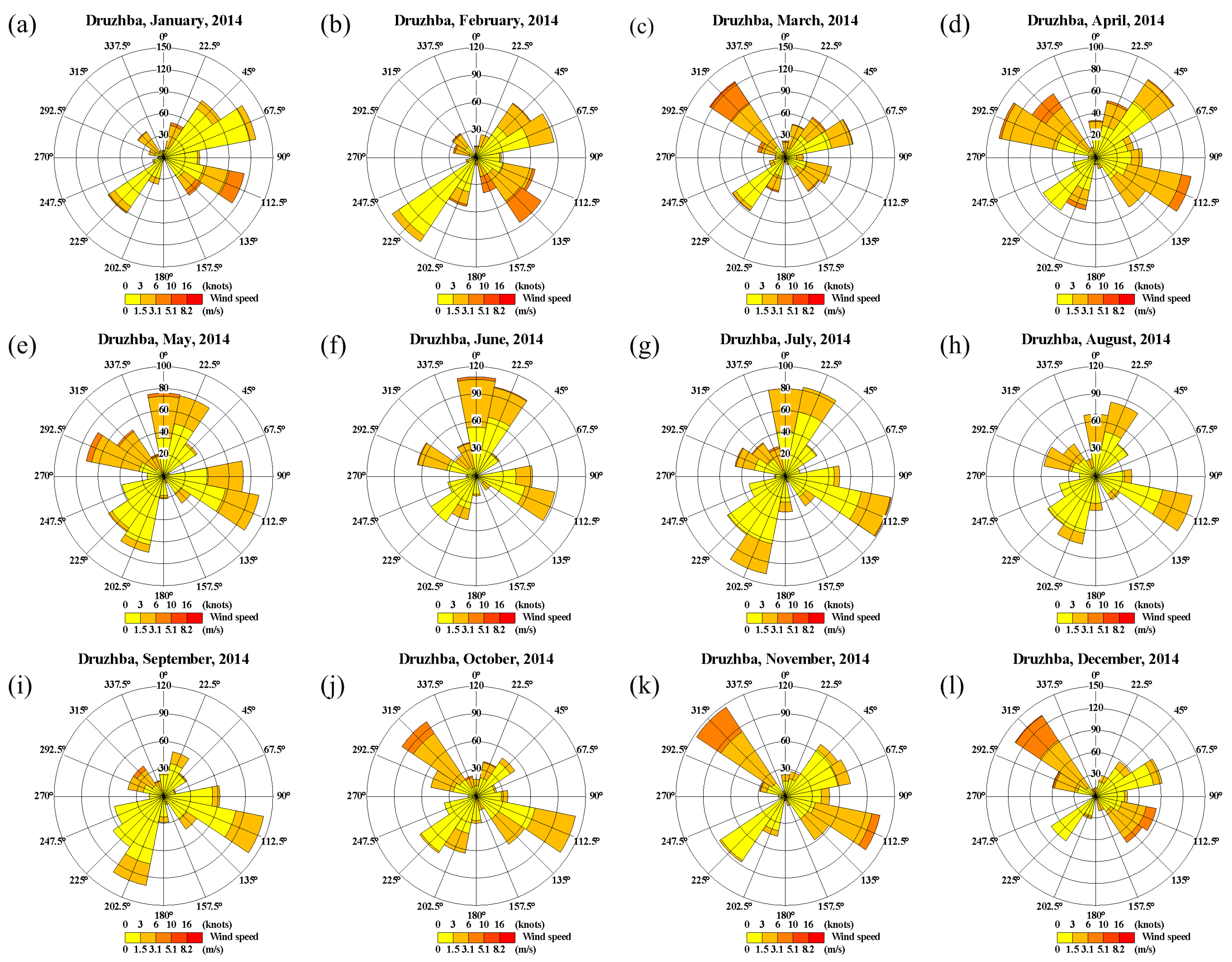
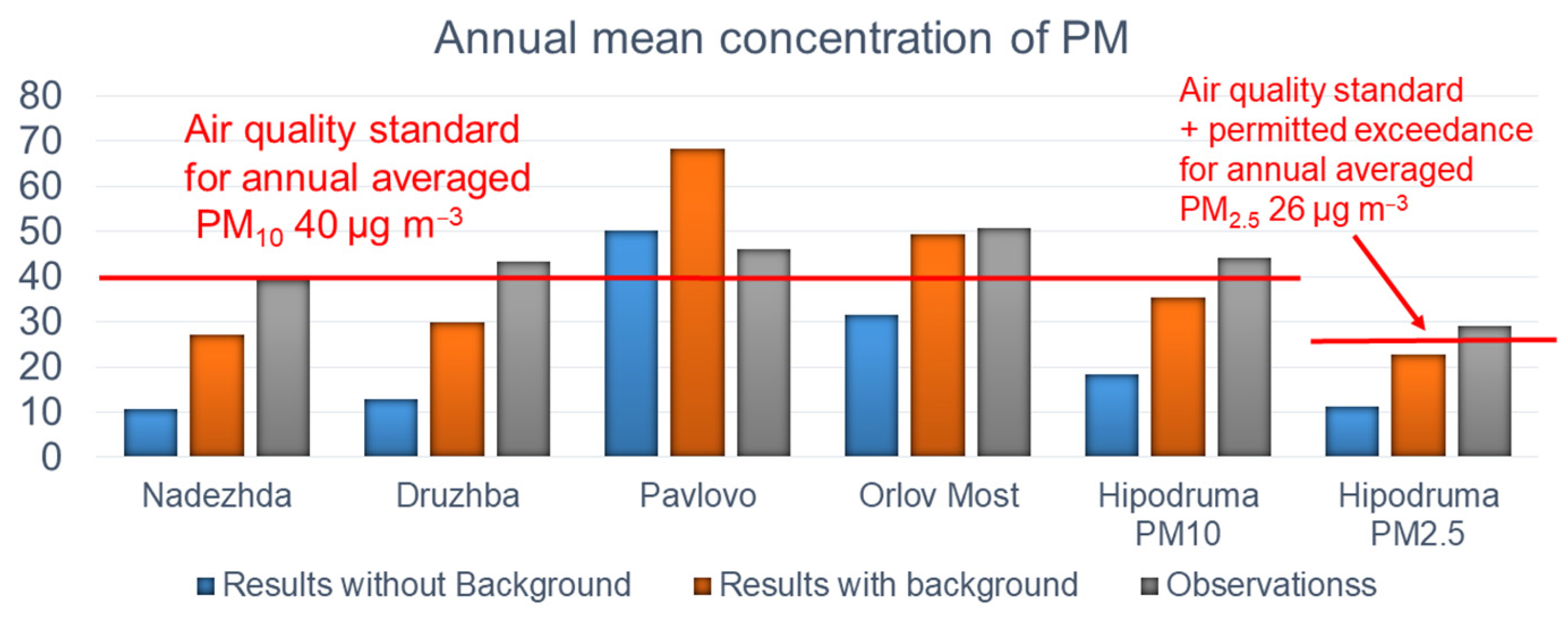
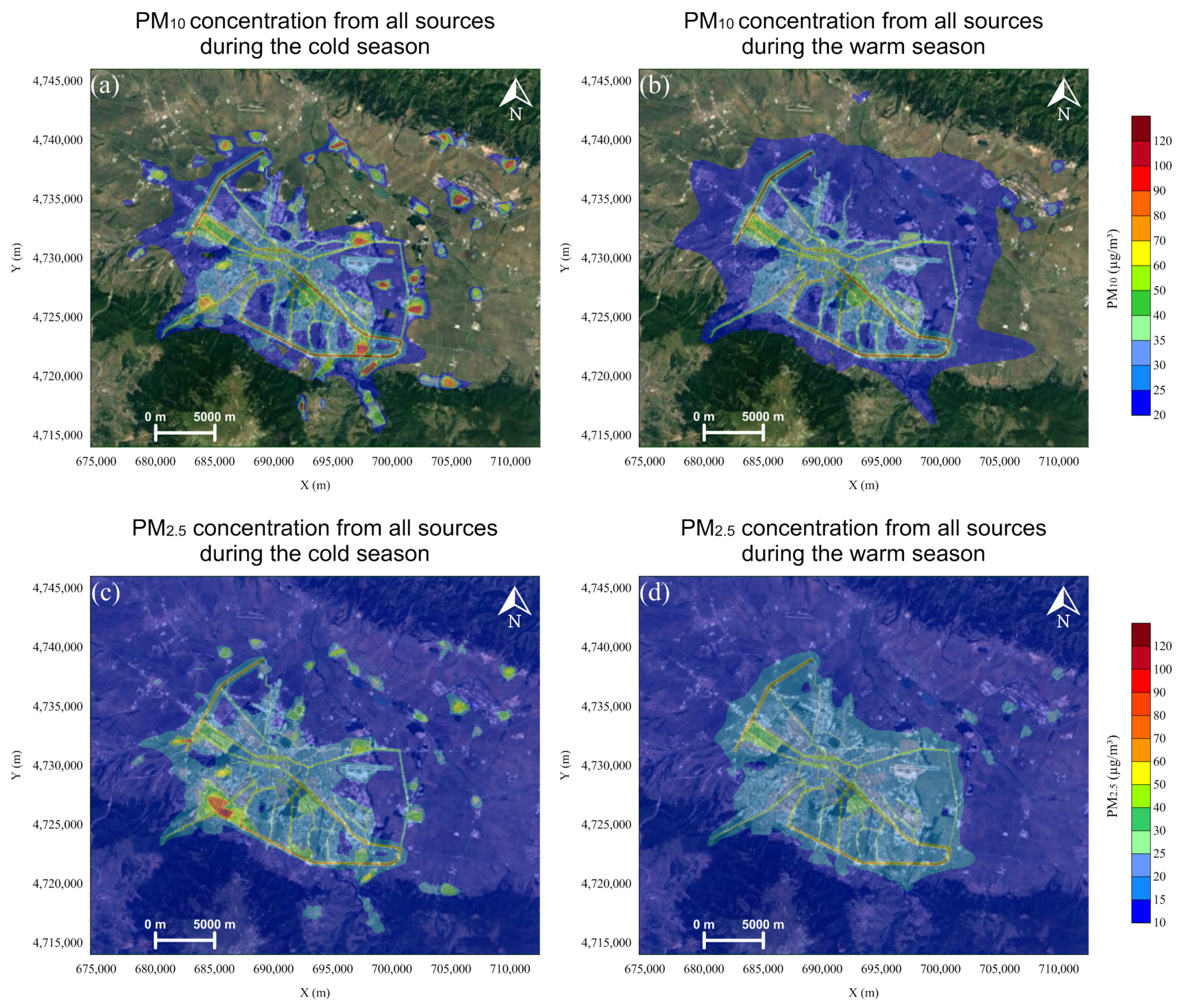
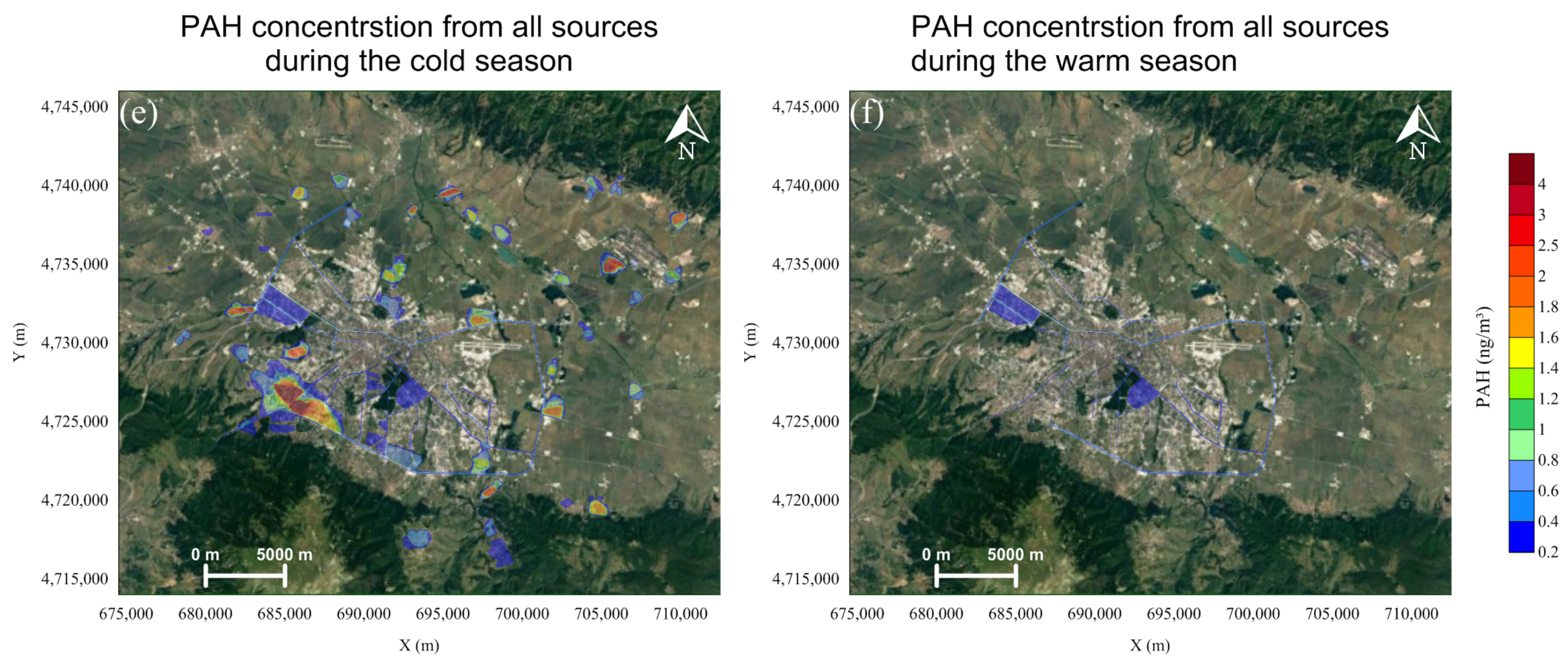
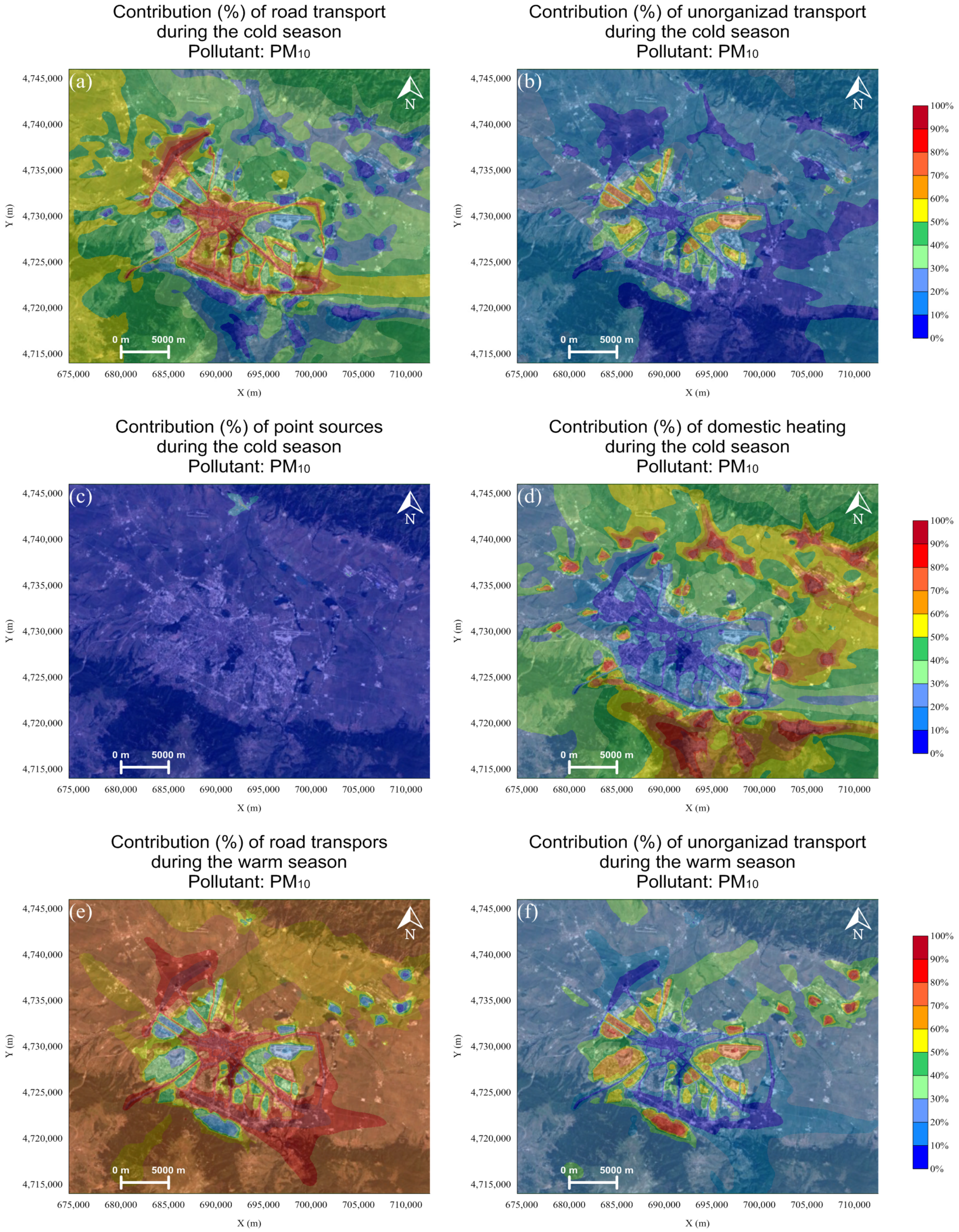
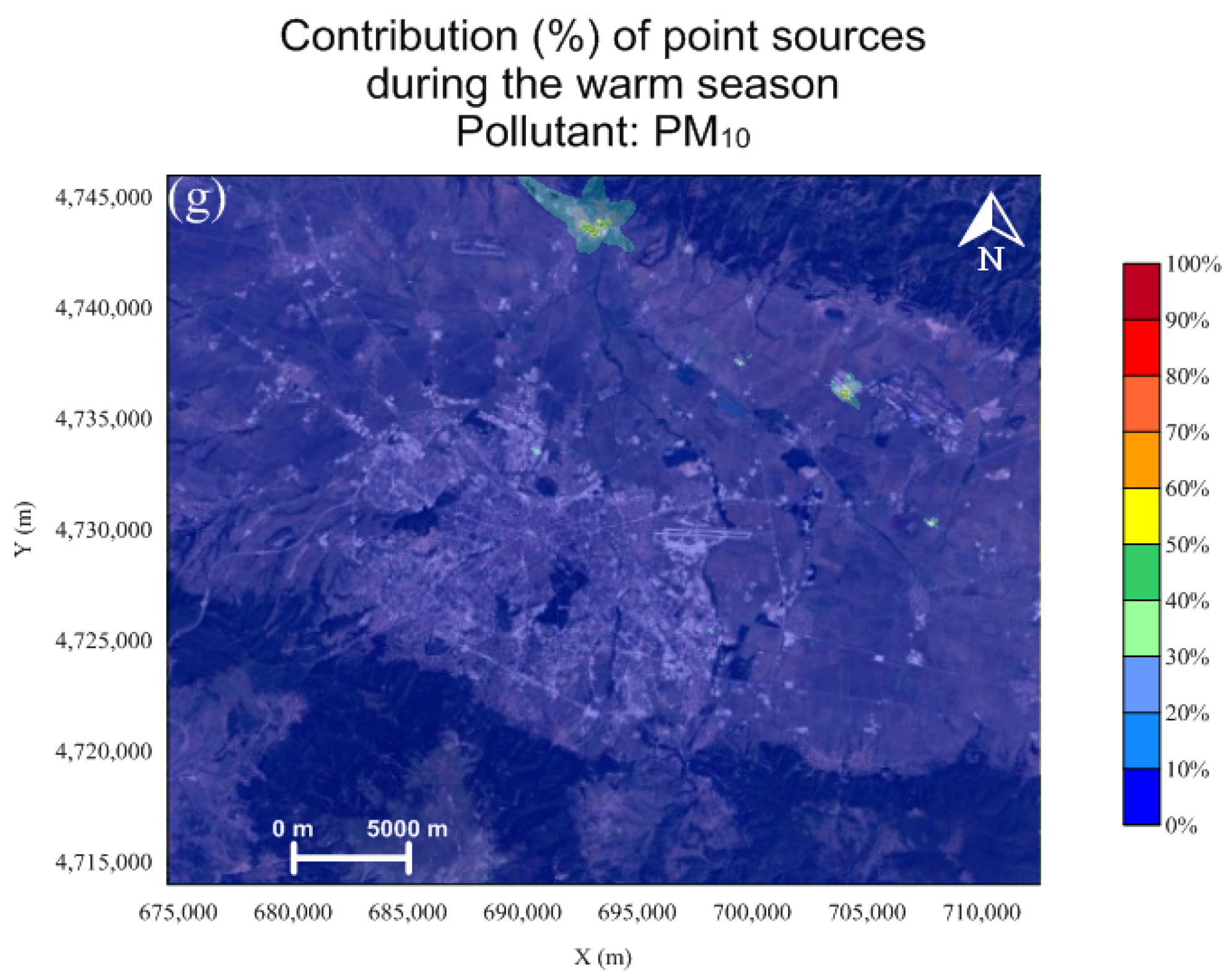
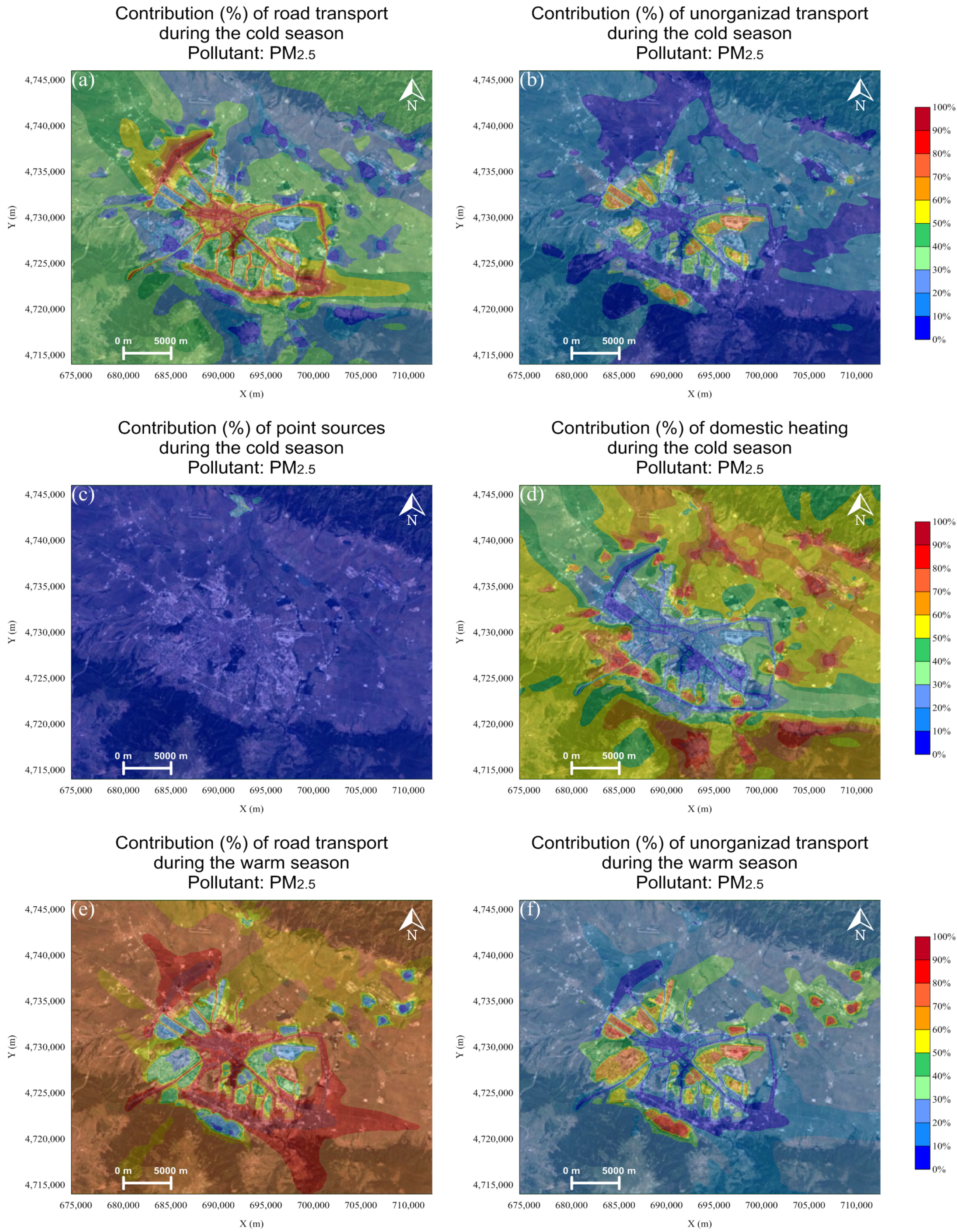
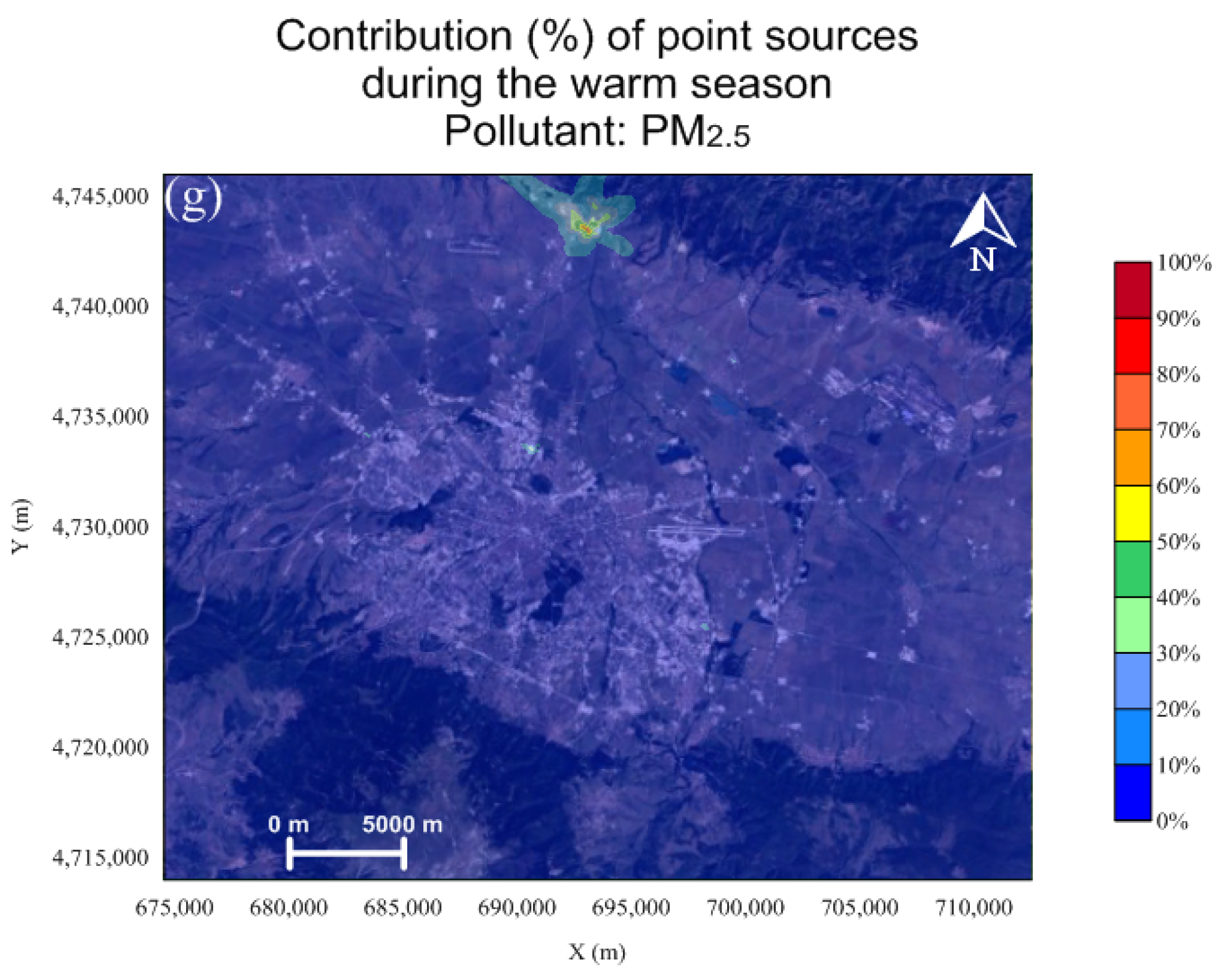
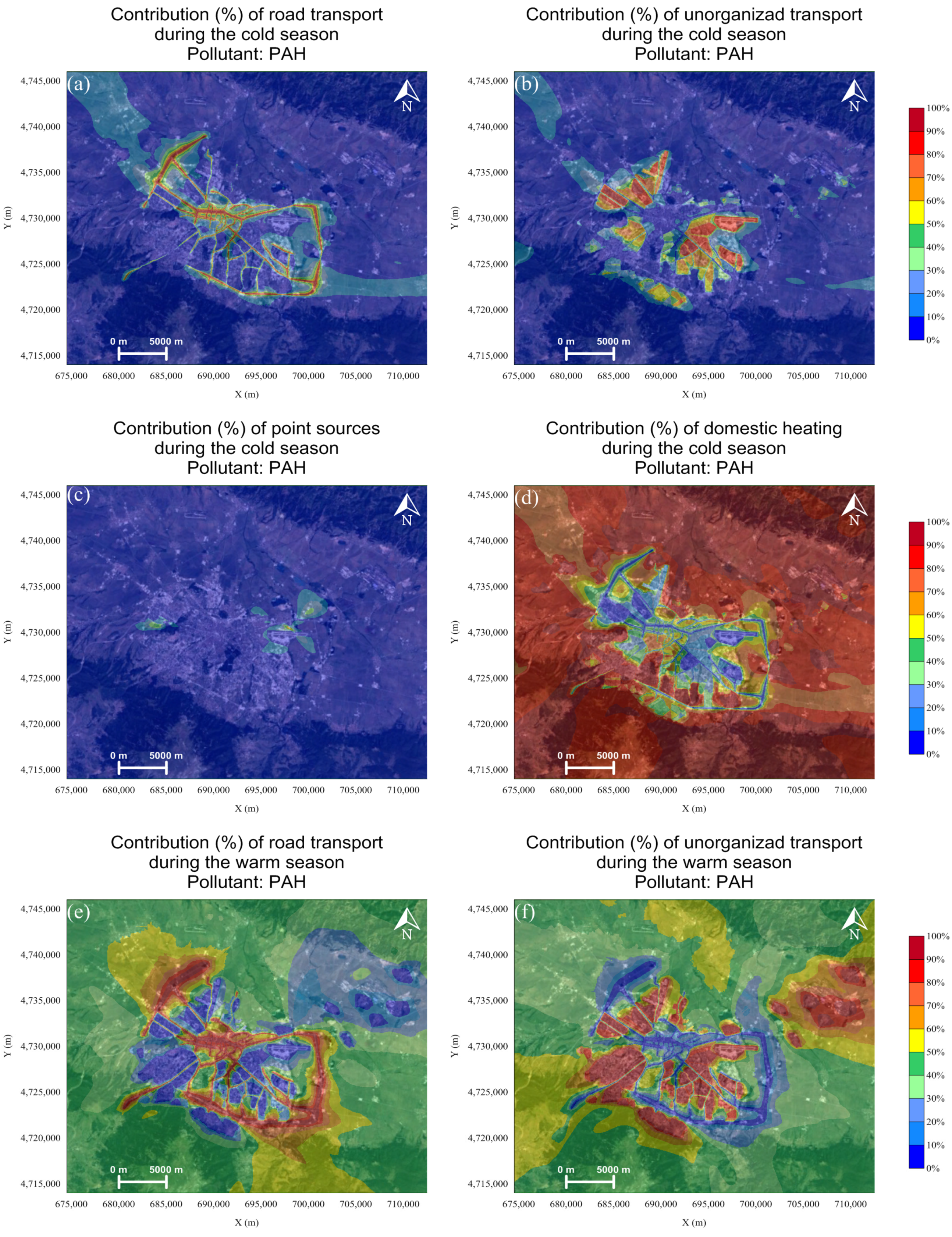
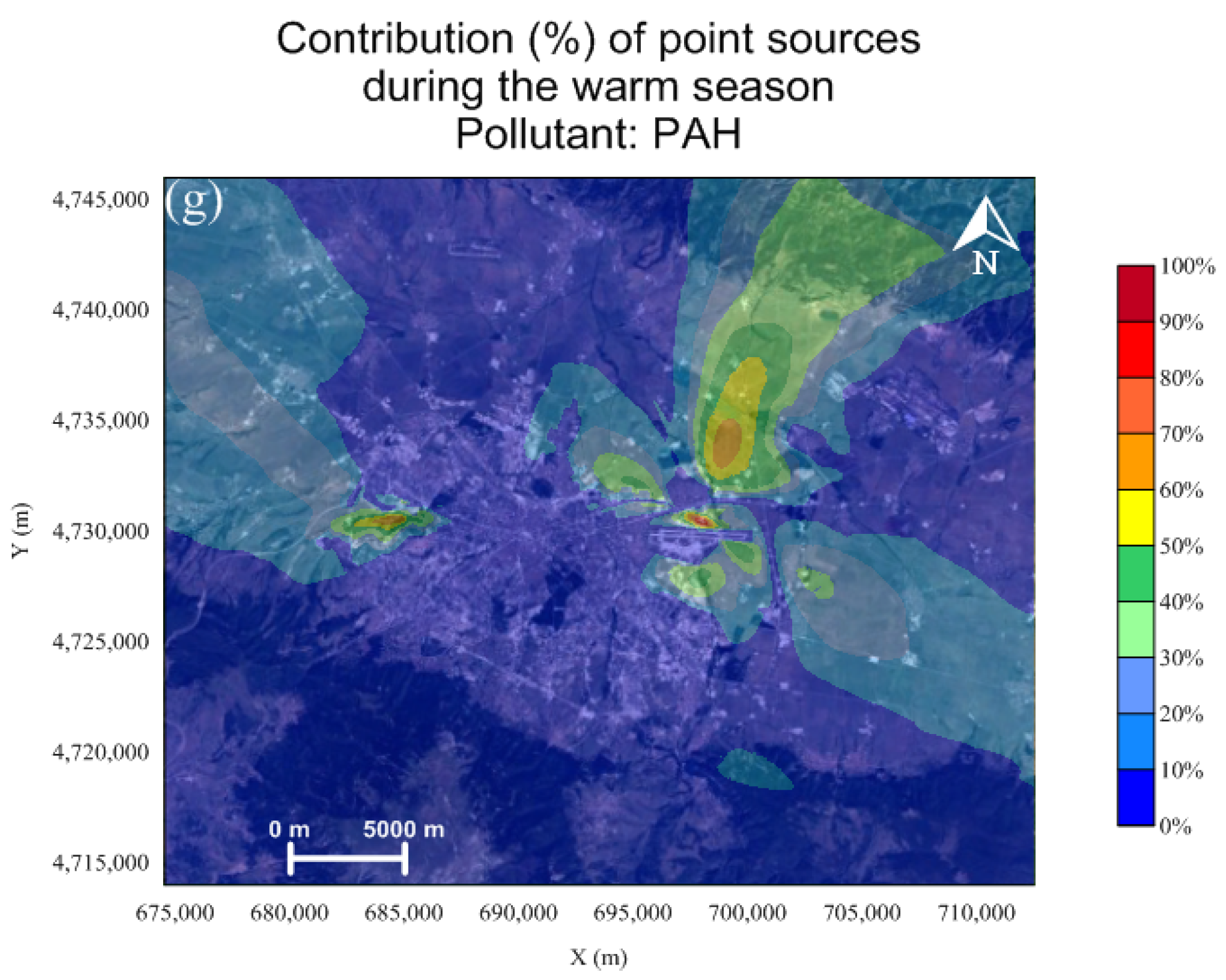
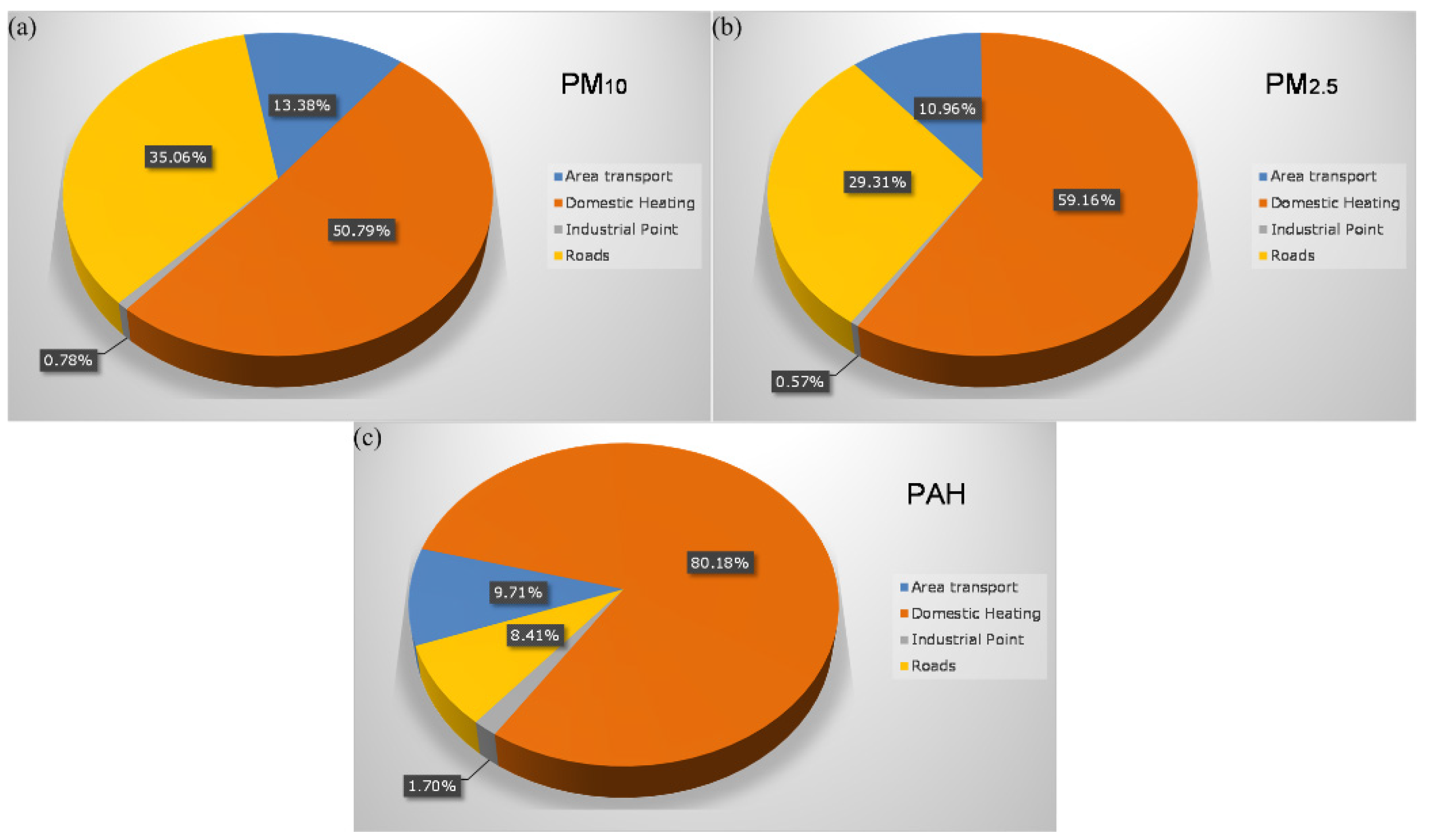
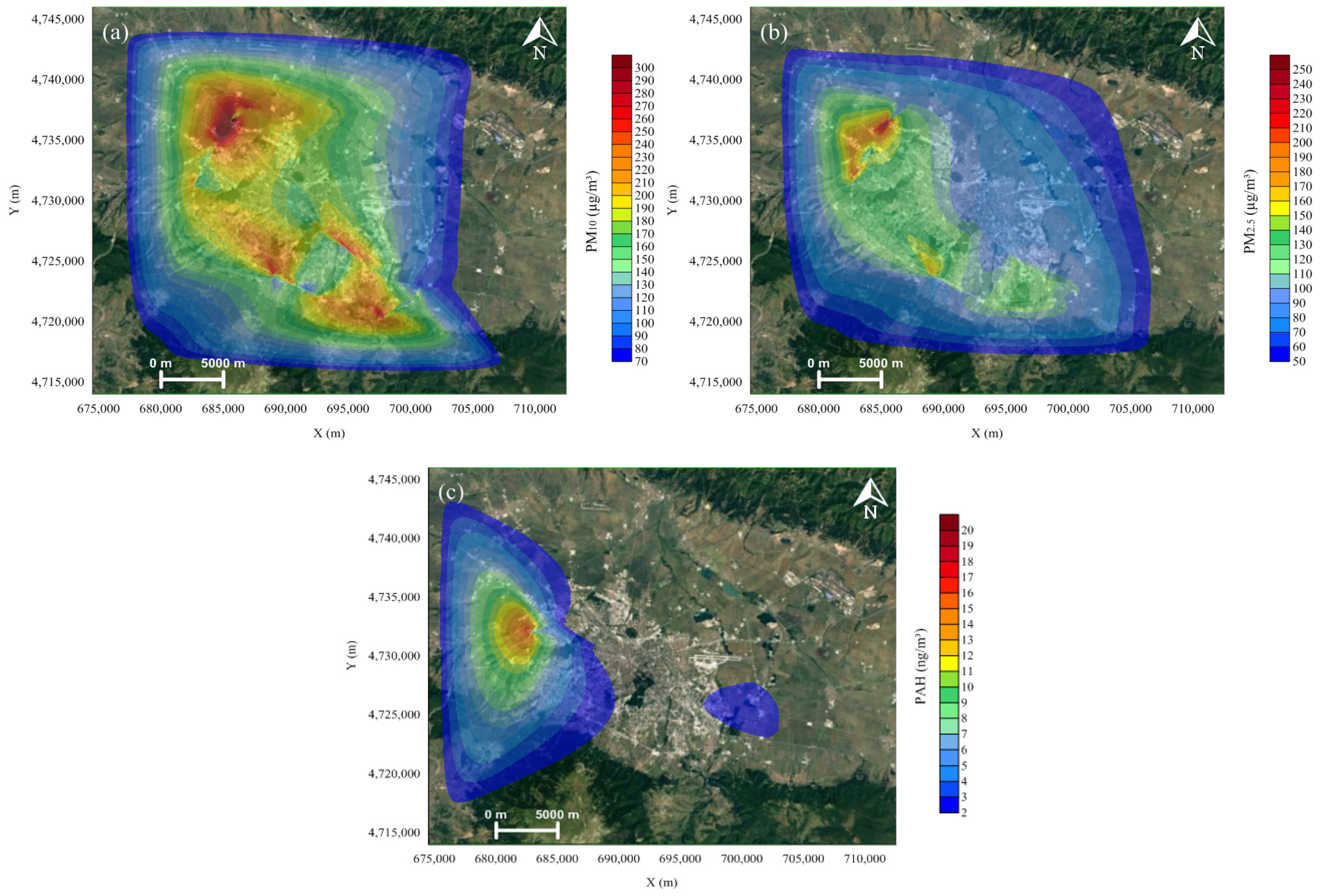
| Statistical Measures | MB | ME | RMSE | IA |
|---|---|---|---|---|
| YEAR 2014 | ||||
| Druzhba—PM10 | −15.29 | 20.51 | 33.60 | 0.39 |
| Nadezhda—PM10 | −14.58 | 18.68 | 33.14 | 0.37 |
| Orlov most—PM10 | −4.79 | 26.91 | 42.96 | 0.43 |
| Pavlovo—PM10 | 18.98 | 34.15 | 43.84 | 0.61 |
| Hipodruma—PM10 | −11.27 | 24.48 | 44.88 | 0.29 |
| Hipodruma—PM2.5 | −8.49 | 19.65 | 38.51 | 0.24 |
| COLD SEASON | ||||
| Druzhba—PM10 | −29.50 | 32.63 | 46.35 | 0.18 |
| Nadezhda—PM10 | −27.75 | 30.80 | 46.17 | 0.20 |
| Orlov most—PM10 | −22.34 | 38.57 | 58.19 | 0.36 |
| Pavlovo—PM10 | 4.52 | 34.73 | 49.65 | 0.70 |
| Hipodruma—PM10 | −30.26 | 38.01 | 62.37 | 0.13 |
| Hipodruma—PM2.5 | −26.00 | 29.83 | 53.59 | 0.08 |
| WARM SEASON | ||||
| Druzhba—PM10 | −1.17 | 8.47 | 10.79 | 0.89 |
| Nadezhda—PM10 | −1.60 | 6.72 | 8.87 | 0.90 |
| Orlov most—PM10 | 12.19 | 15.63 | 18.86 | 0.71 |
| Pavlovo—PM10 | 33.35 | 33.57 | 37.18 | 0.18 |
| Hipodruma—PM10 | 7.34 | 11.22 | 13.23 | 0.86 |
| Hipodruma—PM2.5 | 8.78 | 9.61 | 10.63 | 0.86 |
| Statistical Measures | Mean | SD | ||
|---|---|---|---|---|
| Observational Site | Observation | Model | Observation | Model |
| YEAR 2014 | ||||
| Druzhba—PM10 | 45.25 | 29.97 | 30.70 | 3.92 |
| Nadezhda—PM10 | 41.56 | 26.97 | 30.05 | 4.30 |
| Orlov most—PM10 | 54.09 | 49.31 | 47.33 | 12.59 |
| Pavlovo—PM10 | 49.49 | 68.47 | 47.42 | 20.68 |
| Hipodruma—PM10 | 46.74 | 35.47 | 45.74 | 5.67 |
| Hipodruma—PM2.5 | 31.30 | 22.80 | 38.66 | 4.00 |
| COLD SEASON | ||||
| Druzhba—PM10 | 59.66 | 30.16 | 36.88 | 4.59 |
| Nadezhda—PM10 | 54.11 | 26.37 | 37.81 | 5.14 |
| Orlov most—PM10 | 74.41 | 52.60 | 58.86 | 14.79 |
| Pavlovo—PM10 | 70.93 | 75.44 | 58.95 | 21.58 |
| Hipodruma—PM10 | 66.88 | 36.62 | 48.25 | 6.71 |
| Hipodruma—PM2.5 | 49.17 | 23.17 | 48.25 | 4.48 |
| WARM SEASON | ||||
| Druzhba—PM10 | 30.94 | 29.77 | 10.98 | 3.11 |
| Nadezhda—PM10 | 29.16 | 27.57 | 8.85 | 3.17 |
| Orlov most—PM10 | 33.63 | 45.82 | 13.21 | 9.19 |
| Pavlovo—PM10 | 28.19 | 61.54 | 11.38 | 17.19 |
| Hipodruma—PM10 | 27.00 | 34.34 | 11.32 | 4.14 |
| Hipodruma—PM2.5 | 7.12 | 22.44 | 7.12 | 3.44 |
Publisher’s Note: MDPI stays neutral with regard to jurisdictional claims in published maps and institutional affiliations. |
© 2021 by the authors. Licensee MDPI, Basel, Switzerland. This article is an open access article distributed under the terms and conditions of the Creative Commons Attribution (CC BY) license (http://creativecommons.org/licenses/by/4.0/).
Share and Cite
Dimitrova, R.; Velizarova, M. Assessment of the Contribution of Different Particulate Matter Sources on Pollution in Sofia City. Atmosphere 2021, 12, 423. https://doi.org/10.3390/atmos12040423
Dimitrova R, Velizarova M. Assessment of the Contribution of Different Particulate Matter Sources on Pollution in Sofia City. Atmosphere. 2021; 12(4):423. https://doi.org/10.3390/atmos12040423
Chicago/Turabian StyleDimitrova, Reneta, and Margret Velizarova. 2021. "Assessment of the Contribution of Different Particulate Matter Sources on Pollution in Sofia City" Atmosphere 12, no. 4: 423. https://doi.org/10.3390/atmos12040423
APA StyleDimitrova, R., & Velizarova, M. (2021). Assessment of the Contribution of Different Particulate Matter Sources on Pollution in Sofia City. Atmosphere, 12(4), 423. https://doi.org/10.3390/atmos12040423






